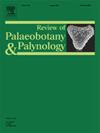湖南中上三叠统巴东组新分散石松类大孢子Tenellisporites capillaris sp. nov.
IF 1.7
3区 地球科学
Q2 PALEONTOLOGY
引用次数: 0
摘要
分散的大孢子化石为了解不同地质时期异孢子石松类的多样性提供了重要的见解。然而,对华南地块中晚三叠世分散石松大孢子的详细系统研究尚缺乏。本文报道了湖南中上三叠统巴东组的一种独特的分散石松类大孢子——Tenellisporites capillaris sp. nov.。这三节大孢子种的特征是狭窄,升高,膜质laesurae具粗糙的指状突起;平坦的赤道带;单根或很少分叉的刺在近端和远端表面都有锋利的尖端。这些刺基部相连,形成一个细小的网状结构,并逐渐向赤道方向增加厚度和长度。超微结构分析表明,大孢子壁由两层组成:1)薄而致密的足部层,2)厚而致密的外层,平行的孢子粉粒单元。最外层的孢子孢粉单元过渡到垂直排列的单元,在那里形成刺状纹饰。形态和超微结构特征表明该大孢子新种属于等生门。该发现是亚洲第一个Tenellisporites化石记录,增强了我们对中晚三叠世等纯石松类古地理分布和多样性的认识。本文章由计算机程序翻译,如有差异,请以英文原文为准。
Tenellisporites capillaris sp. nov., a new dispersed lycopsid megaspore from the Middle–Upper Triassic Badong Formation, Hunan Province, China
Dispersed megaspore fossils provide crucial insights into the diversity of heterosporous lycopsids through geological time. However, detailed systematic studies on Middle–Late Triassic dispersed lycopsid megaspores of the South China Block are lacking. Here, we report a unique dispersed lycopsid megaspore species, Tenellisporites capillaris sp. nov., from the Middle–Upper Triassic Badong Formation in Hunan Province, China. This trilete megaspore species is characterised by narrow, elevated, membraneous laesurae with ragged finger-like projections; a flattened equatorial zona; and single or rarely bifurcate spines with sharp tips on both the proximal and distal surfaces. These spines are connected basally to form a fine reticulum and gradually increase in thickness and length towards the equator. Ultrastructural analysis reveals that the megaspore wall consists of two layers: 1) a very thin and dense foot layer, 2) a thick, dense outer layer with parallel sporopollenin units. The outermost sporopollenin units transition to vertically arranged units where forming the spinous ornamentation. The morphological and ultrastructural characteristics indicate that the new megaspore species belongs to Isoetales. Our finding represents the first fossil record of Tenellisporites in Asia, enhancing our understanding of the palaeogeographic distribution and diversity of isoetalean lycopsids during the Middle–Late Triassic.
求助全文
通过发布文献求助,成功后即可免费获取论文全文。
去求助
来源期刊
CiteScore
3.50
自引率
21.10%
发文量
149
审稿时长
6 months
期刊介绍:
The Review of Palaeobotany and Palynology is an international journal for articles in all fields of palaeobotany and palynology dealing with all groups, ranging from marine palynomorphs to higher land plants. Original contributions and comprehensive review papers should appeal to an international audience. Typical topics include but are not restricted to systematics, evolution, palaeobiology, palaeoecology, biostratigraphy, biochronology, palaeoclimatology, paleogeography, taphonomy, palaeoenvironmental reconstructions, vegetation history, and practical applications of palaeobotany and palynology, e.g. in coal and petroleum geology and archaeology. The journal especially encourages the publication of articles in which palaeobotany and palynology are applied for solving fundamental geological and biological problems as well as innovative and interdisciplinary approaches.

 求助内容:
求助内容: 应助结果提醒方式:
应助结果提醒方式:


